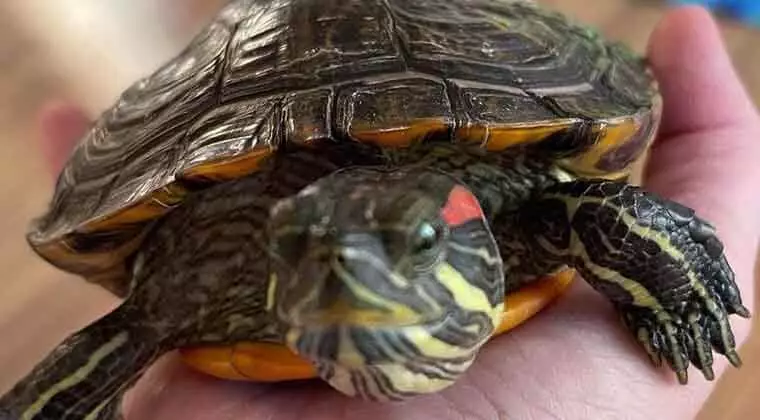Baby red-eared sliders are omnivores, so they need a balanced diet of proteins, vegetables, and fruits. As hatchlings, their diet should be high in protein to fuel growth. They can eat small insects such as crickets or mealworms; live fish like minnows; or commercial turtle food pellets designed for young turtles.
For vegetables, offer leafy greens such as romaine lettuce and spinach along with other items such as zucchini squash and carrots. Fruits like apples, grapes, and melons can also be given occasionally but should not make up more than 10% of the total diet. Feeding baby red-eared sliders twice daily is best practice, offering only enough food that it all gets eaten within 5 minutes each time.
How Often Do You Feed a Baby Red Eared Turtle?
When it comes to feeding a baby red-eared turtle, the general rule is to feed them small amounts daily. It is important that you make sure each meal consists of high-protein foods like fish and insects. You can also supplement their diet with commercial turtle pellets.
Depending on the age of your red-eared turtle, it may need to be fed every day or even multiple times a day in order to get all the nutrients they need for proper growth and health. Younger turtles should be fed smaller amounts more frequently while adult turtles may only require one larger feed per day as long as it contains enough nutrition for them to thrive. Make sure not to overfeed your pet; an excess of food can create unhealthy levels of toxins in their tank which could lead to illness and death.
Can Baby Red-Eared Sliders Eat Lettuce?
Baby red-eared sliders can eat lettuce, but it should not be the primary source of food. Lettuce is low in nutrition and does not provide all of the necessary vitamins, minerals, and proteins that baby turtles need for healthy growth.
Although lettuce can make a tasty snack now and then, most of their diet should consist of things like earthworms, crickets, small fish, or other commercially prepared turtle foods.
Why Is My Baby Red Eared Slider Not Eating?
If your baby red eared slider is not eating, it could be because the water temperature may be too low. These turtles need a warm environment in order to digest their food properly, so make sure that you are providing them with an appropriate temperature of around 75-78 degrees Fahrenheit.
Additionally, check for signs of stress such as if there is too much light or noise in the turtle’s tank or if you recently added new tank mates. If these environmental factors are causing your turtle distress then they may refuse to eat and should be addressed immediately before further health issues arise.
How Do You Take Care of a Baby Red-Eared Slider Turtle?
Taking care of a baby red-eared slider turtle is not as hard as it may seem. First and foremost, you must provide your little friend with a habitat that meets its needs: an aquarium or tub large enough to accommodate both water and land sections; rocks, logs, and other decorations to give the aquatic area some depth; basking areas made up of rocks or driftwood where the turtle can climb out onto dry land; and finally plenty of clean, dechlorinated water.
Additionally, in order for your pet to stay healthy over time you should also provide UVB lighting that mimics natural sunlight and also make sure they have a balanced diet containing protein such as earthworms, shrimp pellets, or feeder fish alongside fresh greens like kale or spinach. Don’t forget regular veterinary check-ups so any issues can be addressed quickly! With these simple steps, you’ll be able to keep your baby red-eared slider happy for years!
Basic Baby Red-Eared Slider Turtle Care
Conclusion
Overall, it is clear that baby red-eared slider turtles require a varied and balanced diet for optimal health. It is important to consider their nutritional needs when deciding what to feed them, as well as the size of the food being offered. Additionally, freshwater vegetation should be included in their diet in order to provide essential vitamins and minerals. With this information, owners can confidently create a healthy feeding plan for their pet turtle!
